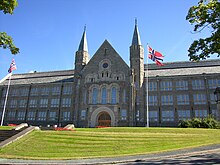You can help expand this article with text translated from the corresponding article in Norwegian. (January 2022) Click [show] for important translation instructions.
|
Norges teknisk-naturvitenskapelige universitet | |
 | |
Former names | NTH |
|---|---|
| Motto | Kunnskap for en bedre verden |
Motto in English | Knowledge for a better world |
| Type | Public university |
| Established | 1996 (1870) |
Academic affiliations | EUA, TIME, CESAER, ATHENS, SEFI, Santander, EAIE, ESN |
| Rector | Tor Grande |
| Students | 43,800 (2023)[1] |
| Location | , Norway |
| Language | Norwegian, English |
| Colours | |
Sporting affiliations | NTNUI |
| Website | ntnu.edu (English) ntnu.no (Norwegian) |
The Norwegian University of Science and Technology (NTNU; Norwegian: Norges teknisk-naturvitenskapelige universitet) is a public research university in Norway and the largest in terms of enrollment.[2] The university's headquarters is located in Trondheim, with regional campuses in Gjøvik and Ålesund.[3]
NTNU was inaugurated by the King-in-Council in 1996 as a result of the merger of the former University of Trondheim and other university-level institutions, with roots dating back to 1760. Later, some former university colleges were also incorporated. Depending on the ranking publication, the university typically ranks within a range of 101 and 400.[4] As of November 2022, the university boasts an approximate 9,000 employees and 42,000 students.[5]
NTNU has the main national responsibility for education and research in engineering and technology. This is likely attributable to the fact that it is the successor of Norway's pre-eminent engineering university, the Norwegian Institute of Technology (NTH) which was established by Parliament in 1910 as Norway's national engineering university. In addition to engineering and natural sciences, the university offers higher education in other academic disciplines ranging from medicine, psychology, social sciences, the arts, teacher education, architecture and fine art. The university's academics include three Nobel laureates in physiology or medicine: Edvard Moser, May-Britt Moser and John O'Keefe.[6]

- ^ Norwegian University of Science and Technology. "Facts and figures – NTNU". Ntnu.edu. Retrieved 2023-06-17.
- ^ "Norway: universities by number of students 2021". Statista. Retrieved 2022-11-06.
- ^ "Campuses - NTNU". www.ntnu.edu. Retrieved 2022-11-06.
- ^ Svendsen, Njord V. (2019-09-01). "Ride, ride ranking på Harvards fang". Khrono.
- ^ "About the university - NTNU". www.ntnu.edu. Archived from the original on 2022-11-06. Retrieved 2022-11-06.
- ^ "John O´Keefe blir professor II ved NTNU".